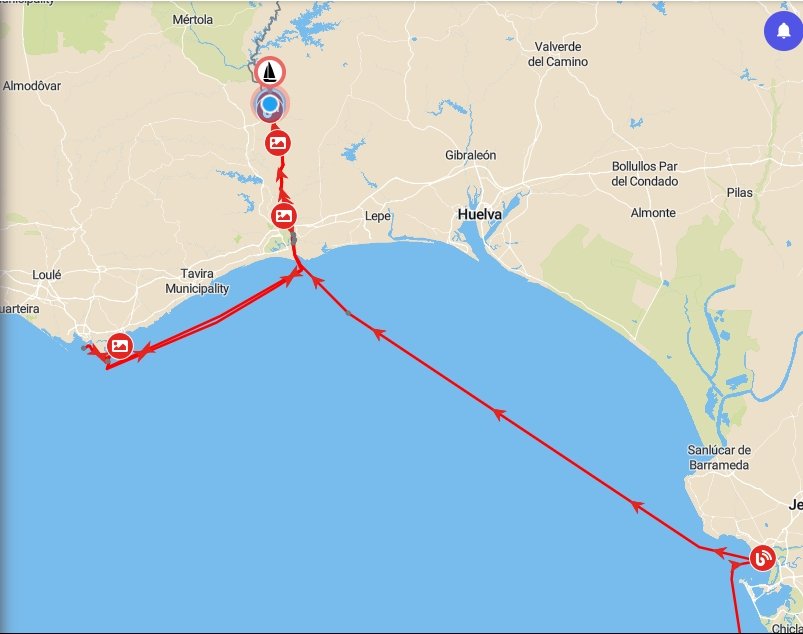Ask people why they travel and I’m sure you’d get a variety of reasons. For me, living on a sailboat allows us to discover and experience new places in an affordable and relaxed manner and all whilst taking our home with us. However, as enjoyable as the new discoveries are, returning to a treasured spot has a special meaning too. One place that really wormed its way into our hearts was the Rio Guadiana.
Rewind to 2014
In 2014 as we headed east towards the Med, friends advised us to pay a visit to the Rio Guadiana. The river forms the border between Spain and Portugal and provides the novel experience to take a masted boat 30nm inland. A road bridge at the seaward end keeps the larger boats away, with mast heights limited to around 20m. Anchorages exist along the river’s length; although the villages of Alcoutim in Portugal and Spanish Sanlúcar de Guadiana provide a focal point for boats to gather.
Back then the floating and land-based community warmly welcomed us, and we enjoyed many hours of socialising. It was April and spring had sprung, coating the hillsides in colour. We walked many miles on the tracks that line the river banks, following the routes smugglers once took. Amongst the fun, Colin found time to build Emerald’s solar panel arch.
I blogged about our experiences on the sailblogs.com platform, here.
There’s a reason why the Rio Guadiana is affectionately known as Glue River. People sail here and choose to get stuck, some replace their floating home with a land home, whilst others float back here year after year.
After five weeks then, we reluctantly moved on, however, the river had hooked itself firmly into our hearts. We vowed to return when the time came to head west. Over seven years we’d stretched the elastic band between us and the river all over the Med and as far east as Turkey, but now we felt it tightening as our return became imminent.
Scene from 2014: arch party, a local festival, wildflowers, Sanlucar




A Dark Departure from Puerto Sherry
Back in the present and it was still full dark as we lifted the anchor at 05:00 and set off north across the Bay of Cadiz. Flashing buoys marked the navigational hazards in the bay, but making them out against the plethora of shore lights kept us on our toes. Added to that was the risk of unmarked fishing pots, prevalent along this coast. So, it was a relief when daylight came.
We had a good breeze behind us, but out beyond the shelter of the bay, we met a swell. Lack of sleep and a rolly motion resulted in an unsettled tum, although it eased somewhat once I could see a horizon. Daybreak also brought a reduction in the wind, and gradually the swell settled down too.
We were motor sailing at a good SOG of 6kts. We discussed sailing, however, we had a deadline to cross the Rio Guadiana sand bar before the tide turned, so we reluctantly continued under motor.
Us: 0, Fish 5

It was disappointing to not be able to sail, but we settled down to enjoy the passage as best we could. Seabird entertainment was plentiful. Fishing boats were out at work, trailing screaming streams of gulls behind them. Shearwaters performed elegant swoops around us, their wings skimming the waves. And snow white gannets bobbed around on the waves.
Inspired by the fishing boats, we decided to try our luck again at fishing. If the professionals were out then there must be fish to be had, right? We have not been blessed with success when it comes to fishing, but not long after deploying the line, we heard the distinctive buzz of the reel spinning as the line paid out. Leaping into action, Colin began to reel in the line. He felt there was definitely some kind of weight on the end. Then suddenly, nothing. He continued to bring in the line but all we found was a clean break. Lure and hook were gone, along with whatever had been attached. Another win for the fish.

And then we came across an unexpected sight. Laying in a line, in deep water, were many tankers and container ships. This wasn’t so unusual in itself, they could be waiting to go into the ports of Huelva or Cadiz. What was unexpected were the huge cruise ships. We guessed they were parked here, with nowhere else to go due to the Covid pandemic. I felt for the crews that would be left onboard to maintain the ships, as it didn’t look to be a very sheltered stretch of water.
Under the Rio Guadiana Bridge
The entrance to the river is marked by a series of red and green buoys, that show the safest path to take across a sand bar. At low tide, the height of the sand bank makes it dangerous for us to cross it. The bar moves regularly, the buoys are moved as needed. We safely crossed the sand bar on the rising tide, two hours before high water.
Having navigated that hazard, the next decision was whether to continue on under the Guadiana International Bridge or wait until tomorrow. Unhelpfully, the information regarding the bridge’s clearance is not clear. The pilot guide states a clearance of 20.5m at high water, yet Navionics shows only 18m vertical clearance. I’m glad we didn’t have Navionics when we safely passed under in each direction back in 2014. Our mast height is 19.5m including the VHF aerial, so based on the pilot guide, even at high water we should be ok.
The tide cycle was on neap tides, which worked in our favour. Tides cycle with the position of the moon between neaps and springs. During neap tides, the height of high water is smaller than during springs. Having studied the tide predictions table combined with the pilot guide’s advice, in theory, there was enough for us to pass safely under the bridge.
Even so, that “should” and “in theory” helped the worms of doubt creep through our minds. Clearly, it would be a very expensive mistake to hit the mast off of a very solid bridge.


No Turning Back
We made the decision to continue. 2kts of current was flowing in and pushing us onwards. With my heart in my throat and my mind throwing shade at my calculations, I stood on the back deck guiding Colin on the helm towards the highest point at the middle of the bridge. Perspective always makes distances look shorter when passing under bridges, even when in reality there are many meters of clearance. As we got closer and closer, our language painted the air blue. The tide swept Emerald on and under the bridge. In the blink of an eye we were through and the mast remained intact.
With our heart rates returning to normal, we continued on a few more minutes before dropping the anchor on the landward side of a red marker buoy. With the engine off, we listened to the sounds of the river. We were far enough away from the bridge that the traffic noise didn’t reach us. Birds sang, and cows mooed as they came down to the river to drink.



North to Larenjeiras
We moved on the next day. Drifting slowly with the rising tide, we set off up river. The foresail was unfurled to catch the southerly breeze and the engine gladly silenced. The gentle sounds of the river rushed in to fill the space. Our speed was slow to start, increasing as the tide built. In the open stretches we touched 5kts, but mostly we drifted along at 3kts. It was bliss.
The bends in the river ensured we kept busy, as each change in direction required gybing the sail. We made sure we kept within the path suggested by the red and green marker posts that guide boats along the deepest part of the river. The river is wide, and the chart showed sufficient depths for us across most of the river. But we didn’t think this was the time to test that theory.
As we slowly made our way north, the river banks changed from flat to rolling hills, with an occasional finca or abandoned Customs House the only buildings. Birds tweeted, herons stood majestically on the banks, nonchalantly looking for food. The land looked brown, parched and dry, although the olive and carob trees displayed swathes of green.
At Larangeiras we chose a spot to anchor south of the moorings and settled for another relaxed evening on the river.



Exploring Around Larenjeiras
The next day we headed for a walk. Starting in the village that hugged the riverside, we headed inland past signs of a recent fire. The landscape is one of rolling hills and so the walk had many ups and downs. We arrived back at the river and a welcome bar. A short final stretch along the riverbank had us back at the starting point and another bar. We had our welcome to Portugal beers – at only €1 I foresee many more of these!








On to Alcoutim
The next morning, we took the last of the flood to continued on another 5nm to the focal point of the Rio Guadiana. There we anchored between the villages of Sanlúcar de Guadiana on the Spanish side, and Alcoutim on the Portuguese. The church bells rang the hours – one hour difference between each bank and 12 minutes late on the Portuguese side, just as we’d remembered from 6 years ago.


Sailing Info
8th September: Puerto Sherry to lower Rio Guadiana – 74nm (1nm sailed)
Anchored in mud, 6m at high water, in position 37 15.458’N 7 26.048’W
9th September: lower Rio Guadiana to Larenjeiras – 9nm (8.5nm sailed)
Anchored in mud, south of moorings, in position 39 24.125’N 7 27.001’W
There is a pontoon with shore access at both Larenjeiras and a little further south at Alamo. Water and electric is available as well as a place to tie up tenders.
11th September: Larenjeiras to south of Alcoutim – 5nm
Anchored in mud, 4.5m, south of the villages in position 37 28.063’N 7 28.130’W

The Social Media Bit: Want to Follow Us?
If you’d like to follow us on other social media platforms (Facebook, Instagram and YouTube), you can do so by using these links:
Or use the link below to track our voyage on NoForeignLand.com.
And finally, you can sign up to receive email notifications of new blogs using the subscribe box at the bottom of this page.
Thank you from Nichola & Colin


